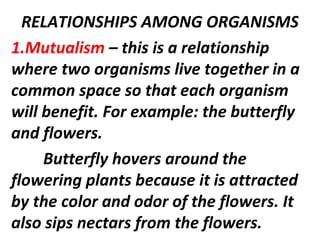
Relationships among organisms
- 1. RELATIONSHIPS AMONG ORGANISMS 1.Mutualism – this is a relationship where two organisms live together in a common space so that each organism will benefit. For example: the butterfly and flowers. Butterfly hovers around the flowering plants because it is attracted by the color and odor of the flowers. It also sips nectars from the flowers.
- 2. The flowers on the other hand, benefit from it because as the butterfly hovers from one flower to another, it transfer pollen grains and pollinates the flowers. The flowers are able to reproduce because the insect carries pollen from flower to flower. Termites and one –celled organisms from a termite intestine also show mutualism.
- 5. The bird cleans the teeth of the crocodile. It picks out small pieces of meat. In return for this service, the crocodile does not harm the bird. There is a free cleaning for the crocodile and a free meal for the bird. Both animals depend upon each other.
- 6. 2. Commensalism – is a kind of relationship by which only one organism benefits. The other is not harmed nor affected at all. Commensal is the one that receives the benefit. The host is the partner that is neither benefited nor harmed. An example of commensalism is the relationship between a shark and a remora. Remora, a sucker fish, attaches itself to the underside of the body of the shark. As the shark feeds, the remora picks up the scraps of food which the shark leaves.
- 8. Another example is an aerial plant or epiphytes growing on the branches of a tree. Orchids cling onto the branches of trees. Their presence does not affect the tree although the tree provides support and place for the orchids to grow. The orchids does not affect the tree because they can manufacture their own food through photosynthesis.
- 10. The relationship between the clownfish and the anemone is another example of commensalism. The sea anemone may look like a plant but it is actually an underwater animal. The long tube like “leaves” are in fact tentacles with stinging cells that project poisonous threads. The sea anemone feeds by stinging prey with its tentacles. The clownfish can swim without fear into the tentacles with open arms of the sea anemone because it has a protective layer of liquid on its body.
- 11. The clownfish seek shelter with the sea anemone’s tentacles and gain protection from its enemies. It also picks up left over food from the sea anemone. The sea anemone gets nothing from the relationship.
- 12. 3. Parasitism – is a kind of relationship where one organism benefits and the other is badly affected. The organism that benefits is the parasite. The organism that is harmed is the host. Parasites cannot live alone. They must live on a living host. Example: Aphids and a rose show parasitism. An aphid is a louse that lives on plants and sucks their juices. Aphids are insect parasite. They are tiny white cotton-like spots underneath the leaves of roses.
- 14. Other example of parasite-host relationships are a flea and a dog.
- 15. Other example of parasite-host relationship is head lice on a child’s hair.
- 16. Parasites that live outside the body of the host is called ectoparasites. Examples: lice, fleas, and ticks
- 17. Parasites that live inside the body of their host are called endoparasites. Examples : hookworms and tapeworms
